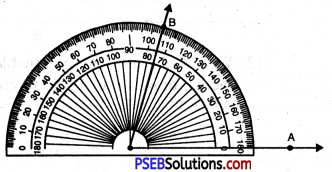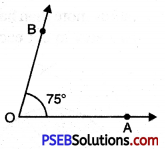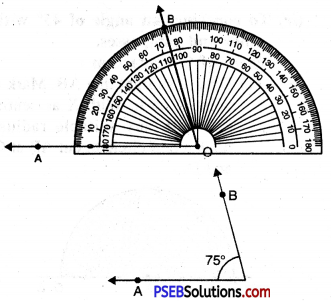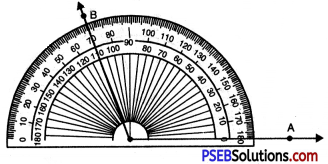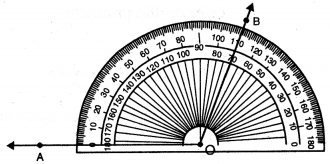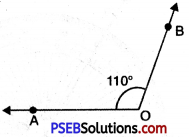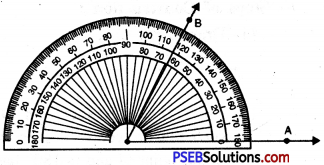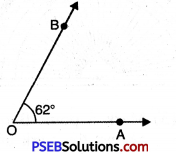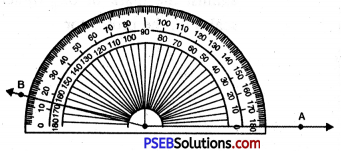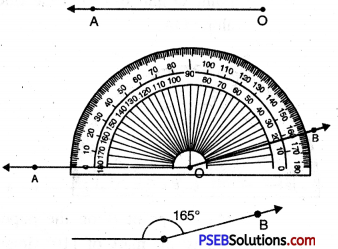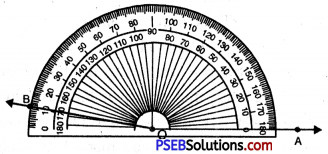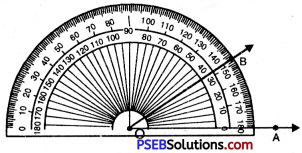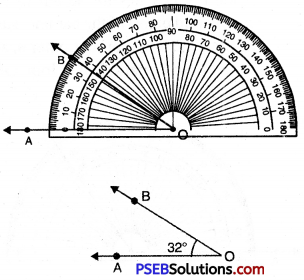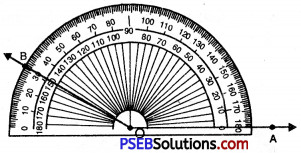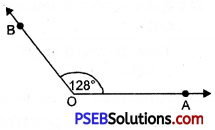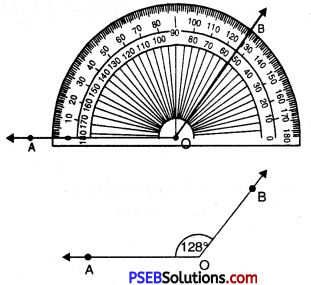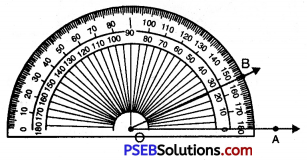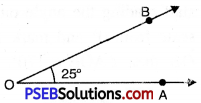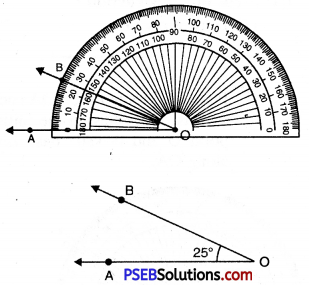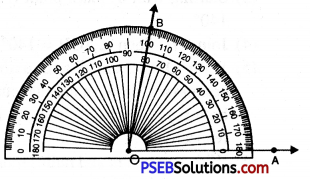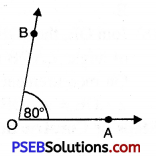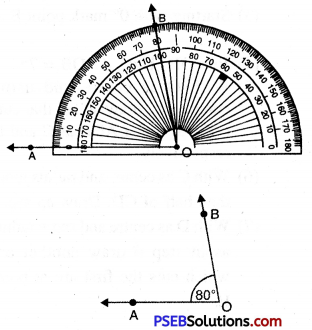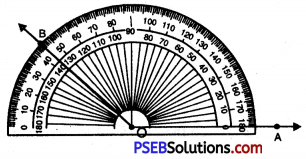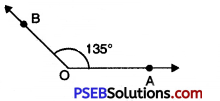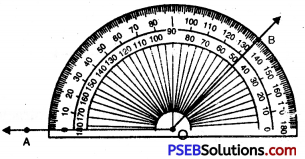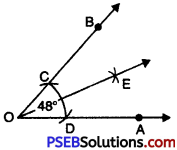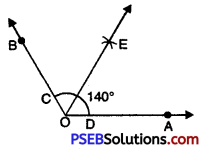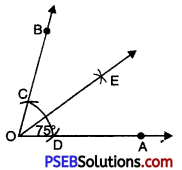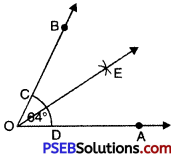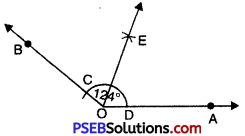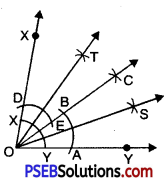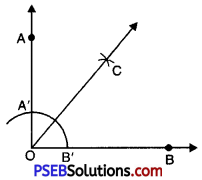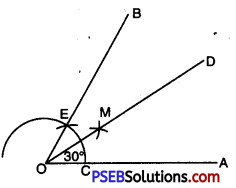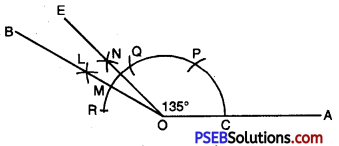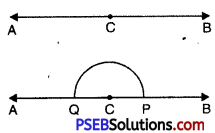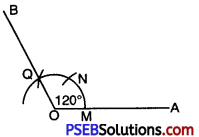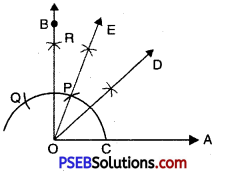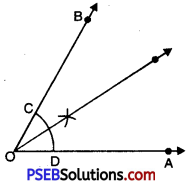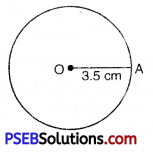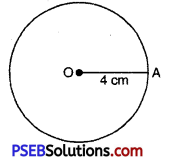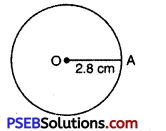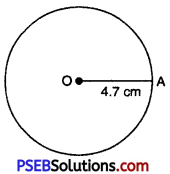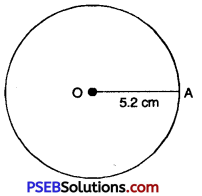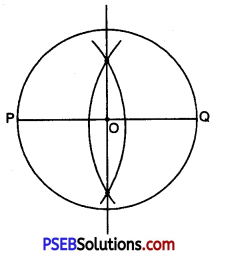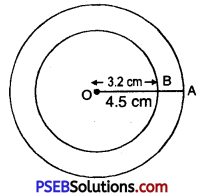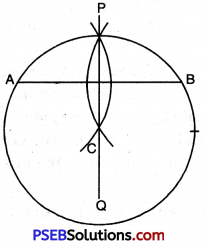Punjab State Board PSEB 6th Class Hindi Book Solutions Hindi Rachana Kahani Lekhan कहानी-लेखन Exercise Questions and Answers, Notes.
PSEB 6th Class Hindi रचना कहानी-लेखन
1. प्यासा कौआ
एक बार गर्मी का मौसम था। जेठ की दोपहर थी। आकाश से आग बरस रही थी। सभी प्राणी गर्मी से घबरा कर अपने आवासों में आराम कर रहे थे। पक्षी अपने घोंसलों में दोपहरी काट रहे थे। ऐसे समय में एक कौआ प्यास से छटपटा रहा था। वह पानी की तलाश में इधरउधर उड़ रहा था, परन्तु उसे कहीं पानी न मिला। अन्त में वह एक उद्यान में पहुंचा। वहाँ पानी का एक घड़ा पड़ा था। कौआ घड़े को पाकर बहुत प्रसन्न हुआ। वह उड़ कर घड़े के पास गया। उसने पानी पीने के लिए घड़े में अपनी चोंच डाली, परन्तु घड़े में पानी बहुत कम था। उसकी चोंच पानी तक न पहुँच सकी।उसके सब प्रयत्न व्यर्थ गए। तब भी उसने आशा न छोड़ी ।
उसी समय उसको एक युक्ति सूझी। वहाँ बहुत-से कंकर पड़े थे। उसने एक-एक घड़े में डालना शुरू कर दिया। थोड़ी ही देर में पानी ऊपर आ गया। कौआ बड़ा प्रसन्न हुआ। उसने जी भर कर पानी पीया और ईश्वर का धन्यवाद किया। शिक्षा-
(क) जहाँ चाह वहाँ राह।
(ख) आवश्यकता आविष्कार की जननी है और
(ग) यत्न करने पर कोई-न-कोई उपाय निकल आता है।
![]()
‘2. फूट का दुष्परिणाम
अथवा
मूर्ख बिल्लियाँ और बन्दर
किसी गाँव में दो बिल्लियाँ रहती थीं। एक दिन दोनों बिल्लियाँ भूख के मारे बेचैन होकर इधर-उधर घूम रही थीं। अचानक उन्हें एक घर से रोटी का टुकड़ा मिला। दोनों बिल्लियाँ रोटी का टुकड़ा लेकर जंगल की ओर चल पड़ी। वे रोटी के टुकड़े को समान भागों में बाँटना चाहती थीं, परन्तु वे आपस में झगड़ने लगीं।
इतने में उधर से एक चालाक बन्दर आ निकला। उन दोनों को झगड़ते हुए देखकर बन्दर ने पूछा- “बहनों झगड़ती क्यों हो ? लाओ मैं इसे बाँटता हूँ।” वह तराजू लाया और रोटी के दो टुकड़े करके पलड़ों पर डाल दिए। एक पलड़ा नीचा था और दूसरा ऊँचा रहा। जिस ओर का पलड़ा नीचे था, उधर से बन्दर ने थोड़ा-सा तोड़ कर खा लिया। अब दूसरा पलड़ा नीचे हो गया, उससे भी कुछ तोड़ कर खा गया। इस प्रकार तराजू का जो भी पलड़ा नीचे हो जाता, बन्दर वहाँ से रोटी का टुकड़ा तोड़ कर खा लेता। अन्त में एक छोटा-सा टुकड़ा बच गया। बिल्लियाँ यह देखकर कहने लगीं- “हमें हमारी रोटी दे दो।” बन्दर कहने लगा, “यह मेरी तोलने की मजदूरी है।” यह कह कर वह बाकी बची रोटी भी खा गया। बिल्लियाँ मुँह देखती रह गईं। शिक्षा-
(1) परस्पर झगड़ने में सदा हानि होती है।
(2) आपसी झगड़े से दूसरे लाभ उठाते हैं।
3. जैसी संगत वैसी रंगत
अथवा
कुसंग का दुष्परिणाम
किसी नगर में एक धनी पुरुष रहता था। उसका एक पुत्र था । माता-पिता अपने पुत्र को लाड़-प्यार करते थे। वह अपनी श्रेणी में हमेशा प्रथम रहता था। उसके अध्यापक भी उसे बहुत प्यार करते और उसकी प्रशंसा करते थे।
दुर्भाग्य से वह बुरे लड़कों की संगति में रहने लगा। उसका ध्यान अब बुरी बातों में लग गया। वह समय पर विद्यालय न जाता और न ही अपना पाठ याद करता। कोई भी अध्यापक अब उसे प्यार नहीं करता था। उसकी शिकायत उसके पिता से की गई। पिता को बड़ी चिन्ता हुई। उन्होंने अपने पुत्र को समझाने के लिए एक उपाय सोचा। वे बाज़ार से एक सुन्दर आमों की टोकरी ले आए। बाद में अपने पुत्र को बुला कर उसे एक सड़ागला आम देकर कहा कि इसे भी टोकरी में रख दो। पुत्र ने वैसा ही किया।
प्रातःकाल पिता ने पुत्र को वही आमों की टोकरी उठा लाने के लिए कहा। जब टोकरी खोली गई तो सारे आम सड़े पड़े थे। पुत्र ने आश्चर्य से पूछा-“पिता जी! ये सारे आम कैसे सड़ गए ?”
पिता ने समझाया, “बेटा, जैसे एक सड़े-गले आम से सारे अच्छे आम खराब हो गए हैं, उसी तरह बुरे लड़कों की संगति से सब अच्छे बालक बुरी बातों को अपना लेते हैं। इसलिए अच्छे बालकों से संगति करो।” पुत्र पर इस बात का बहुत असर पड़ा। उसने बुरे लड़कों की संगति को छोड़ दिया और दिल लगाकर पढ़ने लगा। शिक्षा-
(1) बुरी संगति से बचकर रहो।
(2) बुरी संगति से अकेला भेला।
![]()
4. दो मित्र और रीछ
एक बार दो मित्र इकटे व्यापार करने घर से चले। दोनों ने एक-दूसरे को क्चन दिया कि वे मुसीबत के समय एक-दूसरे की सहायता करेंगे। चलते-चलते दोनों एक भयंकर जंगल में जा पहुँचे। जंगल बहुत विशाल तथा घना था। दोनों मित्र सावधानी से जंगल में से गुजर रहे थे। एकाएक उन्हें सामने से एक रीछ आता हुआ दिखाई दिया। दोनों मित्र भयभीत हो गए। उस रीछ को पास आता देखकर एक मित्र जल्दी से वृक्ष पर चढ़कर पत्तों में छिप कर बैठ गया। दूसरे मित्र को वृक्ष पर चढ़ना नहीं आता था। वह घबरा गया, परन्तु उसने सुना था कि रीछ मरे हुए आदमी को नहीं खाता। वह झट से अपनी साँस रोक कर भूमि पर लेट गया।
रीछ ने पास आकर उसे सूंघा और मरा हुआ समझा कर वहाँ से चला गया। कुछ देर बाद पहला मित्र वृक्ष से नीचे उतरा। उसने दूसरे मित्र से कहा-“उठो, रीछ चला गया । यह तो बताओ कि उसने तुम्हारे कान में क्या कहा ?” भूमि पर लेटने वाले मित्र ने कहा कि रीछ केवल यही कह रहा था कि स्वार्थी मित्र पर विश्वास मत करो।
शिक्षा-
(1) मित्र वह है जो विपत्ति में काम आए।
(2) स्वार्थी मित्र से हमेशा दूर रहो।
5. लोभी ब्राह्मण
किसी वन में एक बूढ़ा शेर रहता था। वह शिकार करने में असमर्थ हो गया। एक दिन : उसे सोने का एक कड़ा जंगल में पड़ा मिला। कड़ा पाकर शेर मन-ही-मन प्रसन्न हुआ। वह एक तालाब के किनारे पर रहने लगा। एक बार एक ब्राह्मण वहाँ से गुजर रहा था। उसे देखकर शेर ने ऊँचे स्वर में कहा, “हे पथिक! यह सोने का कड़ा दान में ले लो।” ब्राह्मण ने शेर से कहा, “तू हिंसक है, तुझ पर कौन विश्वास करेगा ?”
शेर ने उत्तर दिया, “तुम्हारी बात ठीक है, मैंने जवानी में बहुत-से लोगों को मार कर खाया है, किन्तु अब मेरे दाँत और नाखून गल गए हैं। पापों का प्रायश्चित्त करने के लिए तालाब के किनारे पर रहता हूँ। अब इस बुढ़ापे में मैं अपने हाथ का कड़ा भी दान करना चाहता हूँ। इसलिए, आओ तालाब में नहा कर कड़ा ग्रहण करो।
लोभी ब्राह्मण शेर की बातों में आ गया। उसने स्नान किया और वह कीचड़ में फँस गया। शेर ने उसे वहीं पकड़ लिया और मार कर खा गया। इसलिए कहा गया अत्यन्त लोभ नहीं करना चाहिए। शिक्षा-लालच बुरी बला है।
![]()
6. एकता में बल है
किसी गाँव में एक किसान रहता था। उसके चार पुत्र थे। वे सदा आपस में झगड़ते रहते थे। पिता ने उन्हें कई बार समझाया, परन्तु उन पर कोई असर नहीं हुआ। एक दिन किसान सख्त बीमार हो गया, उसके बचने की कोई आशा न थी। उसे एक उपाय सूझा। उसने अपने पुत्रों को बुलाया और एक लकड़ियों का गट्ठा लाने को कहा। जब लकड़ियों का गट्ठा आ गया तो उसने प्रत्येक को उसे तोड़ने के लिए कहा, परन्तु कोई भी गढे को तोड़ने में सफल न हो सका।
फिर बूढ़े किसान ने गट्ठा खोल कर एक-एक लकड़ी तोड़ने के लिए कहा। सब आसानी से लकड़ी तोड़ने में सफल हो गए। तब उसने पुत्रों को समझाया कि एकता में बल है। यदि तुम मिल-जुल कर रहोगे तो तुम्हें कोई हानि नहीं पहुँचा सकेगा। यदि तुम अलगअलग रहोगे तो इन लकड़ियों के समान टूट जाओगे। लड़कों ने लड़ना बन्द कर दिया और मिल-जुलकर रहने लगे। शिक्षा-संगठन में शक्ति है।
7. खरगोश और शेर
किसी वन में भासुरक नामक एक शेर रहता था। वह प्रतिदिन वन के बहुत-से पशुओं को मार देता था। एक दिन वन के पशुओं ने एकत्रित होकर सलाह की कि शेर के पास चल कर उसे समझाएँ कि प्रतिदिन इस प्रकार पशुओं का वध होता रहा तो वन पशुओं से रहित हो जाएगा। यदि एक पशु प्रतिदिन शेर के पास भोजन के लिए चला जाया करे तो पशुओं का इतना नाश न होगा। शेर इस बात पर सहमत हो गया।
एक दिन खरगोश की बारी आई। मार्ग में चलते हुए उसे एक कुआँ दिखाई दिया। झाँक कर देखा तो उसमें उसे अपनी परछाईं दिखाई दी। उसे शेर को मारने का उपाय सूझ गया। वह शेर के पास विलम्ब से पहुँचा। शेर बड़ा भूखा था। उसने क्रुद्ध होकर देर से आने का कारण पूछा। खरगोश ने अनुनय-विनय करते हुए कहा कि मुझे मार्ग में दूसरे शेर ने रोक लिया था। उसके पूछने पर मैंने कहा कि मैं वन के राजा भासुरक के पास भोजन के लिए जा रहा हूँ। उसने कहा कि वन का राजा तो मैं हूँ, भासुरक नहीं। चार खरगोश यहाँ छोड़कर तुम भासुरक को बुला कर लाओ। हम में से जो बलवान् होगा वही खरगोशों को खाएगा। चालाक खरगोश ने कुएँ के पास ले जाकर भासुरक को उसकी परछाईं दिखा दी । दूसरा सिंह समझ कर भासुरक ने कुएँ में छलांग लगा दी और वह मर गया। वन के पशुओं ने सुख की साँस ली। शिक्षा-बुद्धि सबसे बड़ा बल है।
![]()
8. हाथी और दर्जी
किसी राजा के पास एक हाथी था। हाथी प्रतिदिन स्नान करने के लिए नदी पर जाया करता था। रास्ते में एक दर्जी की दुकान पड़ती थी। दर्जी बहुत दयालु तथा उदार था। उसकी हाथी से मित्रता हो गई वह हाथी को प्रतिदिन कुछ खाने के लिए देता था।
एक दिन दर्जी क्रोध में बैठा हुआ था। हाथी आया और कुछ प्राप्त करने के लिए अपनी लँड आगे की। दर्जी ने उसे कुछ,खाने के लिए नहीं दिया, अपितु उसकी सूंड में सूई चुभो दी। हाथी को क्रोध आ गया। वह नदी पर गया। उसने स्नान किया और लौटते समय अपनी सँड में गन्दा पानी भर लिया। दर्जी की दुकान पर उसने सारा गन्दा पानी उसके कपड़ों पर फेंक दिया। दर्जी के सारे कपड़े खराब हो गए। इस तरह हाथी ने दर्जी से बदला लिया।
शिक्षा-जैसे को तैसा।
